American Bonsai at the NC Arboretum
+95
kingsnake
Tom
MKBonsai
BrianS
manumidam
Chris Cochrane
Intricate Simplicity
chench53
KyleT
Maros Belan
DjTommy
Bolero
Gonetopot
Rick36
M. Frary
Van
Toshiro
fiona
Precarious
drbuzzbee
geo
LanceMac10
MichaelS
kimo
Chellis
Leo Schordje
FrankP999
dick benbow
BrianG
crust
TN Jim
Seth Ellwood
Wander
peterkang
Judgie
Kevin S - Wisco Bonsai
Vance Wood
JMcCoy
brett2013
GerhardGerber
lordy
Eric Group
my nellie
steveb
Jaybird
Todd Ellis
jgeanangel
Daygan
AlainK
Richard S
Randy_Davis
Robert J. Baran
David Brunner
William N. Valavanis
Jkd2572
Dale Cochoy
Jesse McMahon
prestontolbert
yamasuri
bingregory
Stephen Krall
DougB
Ashiod
JADunnagan
sayotefries
JudyB
Dan W.
Khaimraj Seepersad
DuncanJH
Dave Murphy
monte
MikeG
augustine
Russell Coker
Kev Bailey
lennard
BigDave
Marty Weiser
Smithy
coh
tmmason10
dorothy7774
gman
Dave Leppo
hometeamrocker
bwaynef
Billy M. Rhodes
Walter Pall
Sam Ogranaja
JimLewis
MartinSweeney
bonsaisr
Auballagh
John Quinn
Arthur Joura
99 posters
Page 15 of 40
Page 15 of 40 •  1 ... 9 ... 14, 15, 16 ... 27 ... 40
1 ... 9 ... 14, 15, 16 ... 27 ... 40 
 With All Due Respect
With All Due Respect
Thank you Brian for posting pictures from my visit with the Greater New Orleans Bonsai Society! Your group is as unique as the great old city for which it is named, full of fun and spice and appealing weirdness. You may have noticed, and others who looked closely at the last picture you posted may have noticed, that I did some further work on the tray landscape beyond what was done at the demonstration. Although I brought with me half a dozen different stones I thought might work in the landscape piece, most turned out to be too large. The only one that fit the available space in the container turned out to be of a color too similar to the trunk of the maple, and so did not provide enough visual interest. When I was back to work on Monday I went out "shopping" among the various collected stones I keep laying about in the nursery and found one that I liked better. It was simple enough to swap them out and I am glad I did, because I find the color and texture of the new stone to be much better.
Your post also affords me an opportunity to step back a moment and acknowledge an important connection that should not be overlooked in my continuing discourse on the idea of Naturalistic and American bonsai. The GNOBS group I recently visited was originally founded by one of the great American bonsai pioneers - Vaughn Banting. When I talk about using native species for bonsai, and more importantly, using personal experience of the native landscape as an inspiration for bonsai design, I am only carrying forward a message that Vaughn Banting was delivering more than 30 years ago. When I went to the US National Bonsai and Penjing Museum as a novice bonsai student in 1993, some of the bonsai that most impressed me were those made of tree species I knew from the woods and forests back home in North Carolina. It was a revelation to me that such plant material could be used for bonsai! One specimen I particularly noted was a forest of Red Maples (Acer rubrum v. drummondii). I looked at the label to see who's work it was, and that was the first time I encountered the name Vaughn Banting.
Most bonsai people who did not know him personally, but know who Vaughn was, identify him with the "flat top" form of Baldcypress (Taxodium distichum). When I was at the National Bonsai and Penjing Museum last spring I made this image of one of Vaughn's most famous trees:
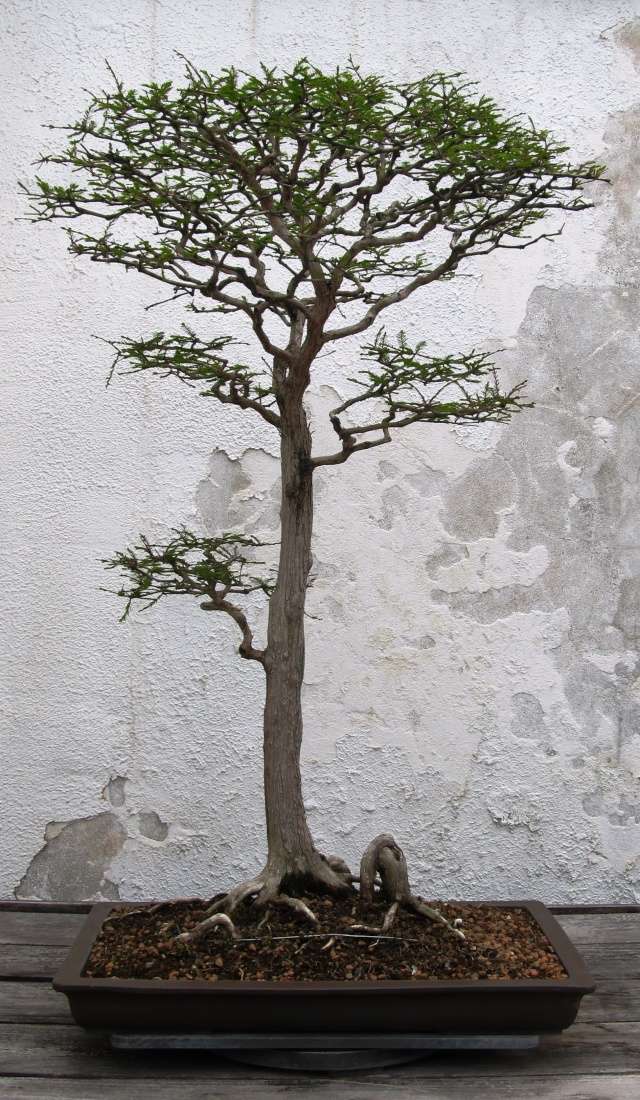
Today the flat top baldcypress form is widely recognized and accepted, but Vaughn Banting was the first to promote it and establish it as an accepted way to shape bonsai. He was a respectful student of the Japanese way of doing bonsai, but he was also a creative person who loved nature and trees in particular. Roaming around the wild coastal region of southern Louisiana he had plenty of opportunity to study great old baldcypress trees in their native habitat. He observed they had a distinctive appearance, and that particular look was not represented among the established forms promoted by Japanese bonsai teaching. So, he took it upon himself to invent a way of creating baldcypress bonsai that looked like real baldcypress in the wilds of the Southeastern US. I do not know if Vaughn labeled his work Naturalistic, but that is what it was. It was also American, because Vaughn was an American, and he was creating out of his personal experience of an American landscape.
Vaughn was a vibrant, positive, engaging person, but his life was cut short by complications arising from brain tumors. His legacy, beyond the beautiful, naturalistic bonsai he left behind in the US National collection and other public collections, is to be found in all the lives he touched, particularly in the world of bonsai. He not only started the club in New Orleans, he traveled extensively as a teacher and wrote many articles for the leading bonsai publications of his day. He had many students, as well as a few disciples. You may recognize some of them by name: Guy Guidry, Gary Marchal, David DeGroot. I never studied with him, but I did get to briefly meet Vaughn not long before he passed away in 2008. We had about a 15 minute conversation, in which time he was able to forever impress upon me the critical difference between vigor and vitality. In my recollection, he said something like this: "Please forgive the slowness of my speech. I have had some health problems and the doctors wound up taking a couple of scoops out of my brain. I do not have the vigor I once did, but the spirit inside me is still strong. I still have my vitality. There is a difference, you know. In bonsai, we strive to suppress a plant's vigor, but we always want to promote its vitality." Vaughn was a natural teacher that way. I am so thankful I got to meet him!
When I go to New Orleans and meet with my GNOB-y friends, I am always highly conscious that I am speaking to the club Vaughn Banting started. Naturally the people in that organization all hold Vaughn in the highest esteem, even those who never knew him, because his memory is kept alive by those who did.
I do not know if Brian, who posted the pictures from my demonstration, was one of the club members who knew Vaughn personally or not, but I know how well he respects his memory. Brian is a pretty fair hand at drawing. If you look at his avatar, it is one of his own drawings, showing a bonsai planted on a rock that happens to be in the shape of the state of Louisiana. Here is another piece of Brian's work, a tribute to the great American bonsai pioneer from Louisiana:

Brian chose to represent Vaughn as he looked in the later years of his life, which is exactly how I knew him. Here is another image of Vaughn, showing him as a much younger man, a Purple Heart combat veteran of Viet Nam who made it home with both his life and his love of living intact, early on in his storied bonsai career:
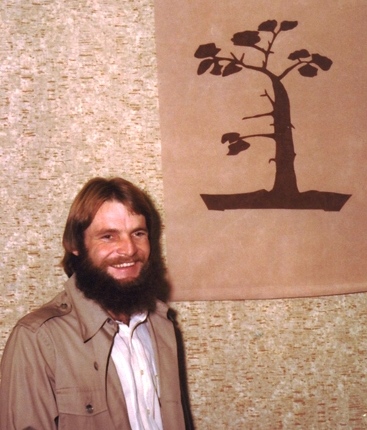
On the wall behind Vaughn is a banner featuring an image of a baldcypress bonsai, the logo to this day of the Greater New Orleans Bonsai Society. (This photograph was made by Vaughn's close friend, and longtime IBC member, Alan Walker.)
***********************************************************************************************************************************
To Kevin - Sorry, but I do not have "before" pictures of the material used in the tray landscape. It would be of little use if I did, because the maple was mostly shaped already and the boxwood was just a bushy thing that was quickly made to look about half as bushy. The purpose of the demonstration was to show the process of choosing and manipulating elements to create an artistically composed landscape impression.
To Randy - Good to hear from you again! I appreciate your take on terminology and do not doubt you are correct. However, I think I will stick to the term I am currently using. No use tempting people to their baser instincts!
To Daygan - What, are you anti-semantic? *
* (This too is a joke.)
Your post also affords me an opportunity to step back a moment and acknowledge an important connection that should not be overlooked in my continuing discourse on the idea of Naturalistic and American bonsai. The GNOBS group I recently visited was originally founded by one of the great American bonsai pioneers - Vaughn Banting. When I talk about using native species for bonsai, and more importantly, using personal experience of the native landscape as an inspiration for bonsai design, I am only carrying forward a message that Vaughn Banting was delivering more than 30 years ago. When I went to the US National Bonsai and Penjing Museum as a novice bonsai student in 1993, some of the bonsai that most impressed me were those made of tree species I knew from the woods and forests back home in North Carolina. It was a revelation to me that such plant material could be used for bonsai! One specimen I particularly noted was a forest of Red Maples (Acer rubrum v. drummondii). I looked at the label to see who's work it was, and that was the first time I encountered the name Vaughn Banting.
Most bonsai people who did not know him personally, but know who Vaughn was, identify him with the "flat top" form of Baldcypress (Taxodium distichum). When I was at the National Bonsai and Penjing Museum last spring I made this image of one of Vaughn's most famous trees:

Today the flat top baldcypress form is widely recognized and accepted, but Vaughn Banting was the first to promote it and establish it as an accepted way to shape bonsai. He was a respectful student of the Japanese way of doing bonsai, but he was also a creative person who loved nature and trees in particular. Roaming around the wild coastal region of southern Louisiana he had plenty of opportunity to study great old baldcypress trees in their native habitat. He observed they had a distinctive appearance, and that particular look was not represented among the established forms promoted by Japanese bonsai teaching. So, he took it upon himself to invent a way of creating baldcypress bonsai that looked like real baldcypress in the wilds of the Southeastern US. I do not know if Vaughn labeled his work Naturalistic, but that is what it was. It was also American, because Vaughn was an American, and he was creating out of his personal experience of an American landscape.
Vaughn was a vibrant, positive, engaging person, but his life was cut short by complications arising from brain tumors. His legacy, beyond the beautiful, naturalistic bonsai he left behind in the US National collection and other public collections, is to be found in all the lives he touched, particularly in the world of bonsai. He not only started the club in New Orleans, he traveled extensively as a teacher and wrote many articles for the leading bonsai publications of his day. He had many students, as well as a few disciples. You may recognize some of them by name: Guy Guidry, Gary Marchal, David DeGroot. I never studied with him, but I did get to briefly meet Vaughn not long before he passed away in 2008. We had about a 15 minute conversation, in which time he was able to forever impress upon me the critical difference between vigor and vitality. In my recollection, he said something like this: "Please forgive the slowness of my speech. I have had some health problems and the doctors wound up taking a couple of scoops out of my brain. I do not have the vigor I once did, but the spirit inside me is still strong. I still have my vitality. There is a difference, you know. In bonsai, we strive to suppress a plant's vigor, but we always want to promote its vitality." Vaughn was a natural teacher that way. I am so thankful I got to meet him!
When I go to New Orleans and meet with my GNOB-y friends, I am always highly conscious that I am speaking to the club Vaughn Banting started. Naturally the people in that organization all hold Vaughn in the highest esteem, even those who never knew him, because his memory is kept alive by those who did.
I do not know if Brian, who posted the pictures from my demonstration, was one of the club members who knew Vaughn personally or not, but I know how well he respects his memory. Brian is a pretty fair hand at drawing. If you look at his avatar, it is one of his own drawings, showing a bonsai planted on a rock that happens to be in the shape of the state of Louisiana. Here is another piece of Brian's work, a tribute to the great American bonsai pioneer from Louisiana:

Brian chose to represent Vaughn as he looked in the later years of his life, which is exactly how I knew him. Here is another image of Vaughn, showing him as a much younger man, a Purple Heart combat veteran of Viet Nam who made it home with both his life and his love of living intact, early on in his storied bonsai career:

On the wall behind Vaughn is a banner featuring an image of a baldcypress bonsai, the logo to this day of the Greater New Orleans Bonsai Society. (This photograph was made by Vaughn's close friend, and longtime IBC member, Alan Walker.)
***********************************************************************************************************************************
To Kevin - Sorry, but I do not have "before" pictures of the material used in the tray landscape. It would be of little use if I did, because the maple was mostly shaped already and the boxwood was just a bushy thing that was quickly made to look about half as bushy. The purpose of the demonstration was to show the process of choosing and manipulating elements to create an artistically composed landscape impression.
To Randy - Good to hear from you again! I appreciate your take on terminology and do not doubt you are correct. However, I think I will stick to the term I am currently using. No use tempting people to their baser instincts!
To Daygan - What, are you anti-semantic? *
* (This too is a joke.)
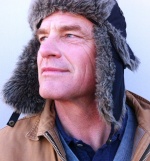
Arthur Joura- Member
 Re: American Bonsai at the NC Arboretum
Re: American Bonsai at the NC Arboretum
Of great respect is the person who can move the spotlight from his or her head and honor others. Thank you Arthur for honoring one of our American combat heroes and a founder of bonsai in America.
As a side note, badly needed is a book/consolidation of the bio's of all of our known and unknown founders.
As a side note, badly needed is a book/consolidation of the bio's of all of our known and unknown founders.

DougB- Member
 Re: American Bonsai at the NC Arboretum
Re: American Bonsai at the NC Arboretum
Arthur,
I am glad that you mentioned Vaughn. I never got to meet him and I had only been in bonsai for a few short years when a passed away. However, there was some amazing things written about him after his passing that I found and became inspired by as I read more about the man. He not only inspired me to think about bald cypress as a bonsai material, but my first bald cypress bonsai was styled in the flat top style. To me this is how I see bald cypress naturally in my area. They are around ponds and lakes, or in swampy settings and have had to compete for the sunlight with other species of trees. For me the pyramidal shape of bald cypress usually indicates a young tree, or one that has been planted specially for landscaping and given plenty of room to grow. I find this less appealing.
Last spring I was up at the PBA show which is held at the National Arboretum and I had a opportunity to go through the collection. One of the things that I remember the most about walking through was seeing a Acer rubrum forest there and then to my surprise it had Vaughn's name on it. I guess I never realized that he had done a piece like this, or at the time of my interest in his work, I was focused on the bald cypress species. However, early on, I became interested in the Acer rubrum as potential bonsai material, but was told that it would not make a good bonsai because of the size of the leaves, and at that time, I was still pretty new to bonsai so I believed it when others with much more experience told me it would not be good material to use. But the thought continued to linger in my head and I actually started growing some accidentally. I worked with one of them for several years, but still continued to get push back from others about the leaf size. However, I knew I could fix that and had some success doing so. But it wasn't until one of my trips to the NC Expo that my faith in Acer rubrum were solidified when I saw some of the pieces you had created. I finally felt a little justified in my perseverance with this species. I was also lucky enough to win one of your pieces and the auction and it one of my favorite bonsai. So, in a way I would like to think that Vaughn also has a role to play through you in my interest in Acer rubrums. This spring I will be putting together a forest planting of Acer rubrum seedlings which will be called "Pholia's Forest".
Steve
I am glad that you mentioned Vaughn. I never got to meet him and I had only been in bonsai for a few short years when a passed away. However, there was some amazing things written about him after his passing that I found and became inspired by as I read more about the man. He not only inspired me to think about bald cypress as a bonsai material, but my first bald cypress bonsai was styled in the flat top style. To me this is how I see bald cypress naturally in my area. They are around ponds and lakes, or in swampy settings and have had to compete for the sunlight with other species of trees. For me the pyramidal shape of bald cypress usually indicates a young tree, or one that has been planted specially for landscaping and given plenty of room to grow. I find this less appealing.
Last spring I was up at the PBA show which is held at the National Arboretum and I had a opportunity to go through the collection. One of the things that I remember the most about walking through was seeing a Acer rubrum forest there and then to my surprise it had Vaughn's name on it. I guess I never realized that he had done a piece like this, or at the time of my interest in his work, I was focused on the bald cypress species. However, early on, I became interested in the Acer rubrum as potential bonsai material, but was told that it would not make a good bonsai because of the size of the leaves, and at that time, I was still pretty new to bonsai so I believed it when others with much more experience told me it would not be good material to use. But the thought continued to linger in my head and I actually started growing some accidentally. I worked with one of them for several years, but still continued to get push back from others about the leaf size. However, I knew I could fix that and had some success doing so. But it wasn't until one of my trips to the NC Expo that my faith in Acer rubrum were solidified when I saw some of the pieces you had created. I finally felt a little justified in my perseverance with this species. I was also lucky enough to win one of your pieces and the auction and it one of my favorite bonsai. So, in a way I would like to think that Vaughn also has a role to play through you in my interest in Acer rubrums. This spring I will be putting together a forest planting of Acer rubrum seedlings which will be called "Pholia's Forest".
Steve

Stephen Krall- Member
 Recovery
Recovery
Thanks to Doug and Steve for reading and commenting on my last post.
When I travel to different places to present educational bonsai programs, if at all possible I will incorporate a little sightseeing into the trip. My focus is typically on natural areas, although historic sites are also of interest. Coming back from New Orleans, after stopping at Rouses to stock up on Gulf shrimp, fresh crab meat, and Louisiana-raised catfish, I drove east a short distance and stopped at Bayou Savauge National Wildlife Refuge. It was still fairly early on a pleasant Sunday morning and I was the only one there:

At the welcome center, pictured above, there was interpretive signage explaining the role of bayous in the Gulf coast Eco-system, and also showing how drastically this particular area had changed back in August of 2005. For those who do not know, or have perhaps forgotten, that was the time of Hurricane Katrina. Most of the media attention surrounding the Katrina disaster focused on New Orleans, which is not surprising given the population density there, and the fact that the levy system, designed to protect the low lying city against flood waters, failed completely. But Katrina wreaked havoc all along the Gulf coast, from Florida to Texas. Great as the devastation was to human habitats, it was no less so for the natural areas and all the life contained within them. Bayou Savauge, which is actually within the New Orleans city limits and behind part of the levy system, was severely damaged. A person visiting there now and not looking closely at things, however, might not know it.
There is an old adage: "Time heals all wounds". It has been nearly 10 years since Hurricane Katrina, and in that time much of the destruction it wrought, although certainly not all of it, has been smoothed over. A couple of friends from GNOBS took me for a drive downtown and along the way the conversation turned to what it was like in New Orleans in the early post-Katrina days. I listened with great interest to their personal accounts of what they witnessed, and as someone who did not see it himself, it had to me the air of the fantastic. As I looked out at the city passing by before the car window, it was difficult to imagine how the devastation they were describing eventually transformed again into what appeared to me a normal scene. Every now an then, however, we would pass a vacant lot or a building still boarded up 10 years later, and these things were testimony to the terrible event and the ongoing process of recovery.
The story at Bayou Savauge is much the same. The interpretive signage at the welcome center tells of the damage sustained in the storm 10 years ago and all the efforts made to restore the landscape since then, of what was lost and what has returned and what has not. There is a short boardwalk trail through part of the refuge. Here is a picture of part of it:

At the welcome center a picture on the interpretive signage showed a similar view, but it also showed an image of how it appeared before the hurricane. It looked like a completely different place. There were certain plant species - baldcypress (Taxodium distichum) and saw palmettos (Serenoa repens), for example - that were abundant in the "before" photo and completely absent now. We think of damage from hurricanes as being primarily a result of high winds, but much of the Gulf coast plant life destroyed by Katrina was due to salt water intrusion. During the Katina storm surge ocean waters were as much as 14ft. (4.3m) above normal, which introduced salt water to vast fresh water areas. Some plants can tolerate salinity to varying degrees, but others cannot tolerate it at all. Those plants, the ones that cannot tolerate salt, were just wiped out. After 10 years there is little evidence that they ever existed. Other plants have taken their place.
The damage done by the high winds is a different story. There are still some standing mature trees at Bayou Savauge, but none of them are whole. In some cases it is plainly evident, even to the eyes of the undiscerning, I should think, that the trees underwent some traumatic event. For example, here are some sweetgums (Liguidamber styraciflua):

These trees appear to have had most all their limbs completely sheared off, leaving their straight trunks standing like telephone poles. In 10 years' time they have made a good start on growing replacement limbs, but none of those have yet the correct proportional relationship to the size of the trunk from which they emerge.
Here is another recovering tree, this time a southern hackberry (Celtis laevigata):

This example seems to have restored itself a bit more quickly than the sweetgums, perhaps owing to the fact of being a generally fast growing species. This tree looks almost normal, and I suspect that when it is in leaf it appears even more so. However, in its bare form we can clearly see where large limbs were ripped off, and where new growth has sprouted out of the stumps to carry on.
Another hackberry, more damaged but the same story of regrowth:

Southern live oaks (Quercus virginiana) are among the most picturesque of North American trees, and the Gulf coast is an area rich in them. These particular live oaks are not so beautiful in their present form:

It is not difficult, when looking at these 2 trees, to surmise from which direction the strong winds blew. They have recovered to this extent in 10 years' time, but what will they look like 10 years from now, or 100 years from now? Assuming they live so long, they may well be completely awesome in their form. They may cause tree lovers of the future to stop and stare in amazement. Right now they do not look so appealing, but they no doubt look much better than they did back in September of 2005. This is the nature of recovery - it takes time.
There is also inherent in the process of recovery some element of greater character. In order for any given thing to recover - whether tree or environment, city or individual human being - it must first suffer some serious setback. A thing must be beaten, broken, perhaps even brought to its knees before any process of recovery can begin, if it happens at all. From that low beginning, an entity that seeks to recover must first endure, and summon the will to go on. It must suffer the defeat but fight back, and persist in the struggle for however long it takes. Forever after that, it bears the stamp of the ordeal, for better or for worse. This is what I mean by character. The trees I saw at Bayou Savauge survived the ordeal of Hurricane Katrina and have been in recovery for 10 years now. They were reshaped by the ordeal, and bear the scars to prove it. If they can hold on, if they can continue to recover, time will continue to smooth over the damage until one day the scars will be mostly erased, and those that can still be plainly seen will be enhanced and made majestic by the grace of time. They will have greater character than any of their kind that never underwent a similar ordeal.
Do I need to point out that this has everything to do with bonsai?
This process of recovery, as it relates to trees and other woody plants, is at the heart of what we do in bonsai, both in a mechanical and a spiritual sense.
On the mechanical side, the ability of woody plants to respond to loss by growing new parts is not only what allows a tree to recover when all of its branches are ripped of in a hurricane, it is also what enables us to prune. Without pruning, the art of bonsai would be impossible.
In the spiritual sense, the character displayed by an old tree that has survived the hardships of many years, and particularly those that have survived life-altering ordeals, are what we seek to capture and pay tribute to in our bonsai work. In my view of it, the very best bonsai all evoke this sense of respect for the character that is achieved through the eternal struggle of life - hardship, disaster, loss, endurance, recovery, the will to survive. This is a story that humans respond to at a deeply meaningful level. It is what stops us in our tracks when we see trees of great character, whether they be clinging to life on some brutally exposed rock outcrop high on a mountaintop, or cultivated in a shallow tray in someone's back yard.

When I travel to different places to present educational bonsai programs, if at all possible I will incorporate a little sightseeing into the trip. My focus is typically on natural areas, although historic sites are also of interest. Coming back from New Orleans, after stopping at Rouses to stock up on Gulf shrimp, fresh crab meat, and Louisiana-raised catfish, I drove east a short distance and stopped at Bayou Savauge National Wildlife Refuge. It was still fairly early on a pleasant Sunday morning and I was the only one there:

At the welcome center, pictured above, there was interpretive signage explaining the role of bayous in the Gulf coast Eco-system, and also showing how drastically this particular area had changed back in August of 2005. For those who do not know, or have perhaps forgotten, that was the time of Hurricane Katrina. Most of the media attention surrounding the Katrina disaster focused on New Orleans, which is not surprising given the population density there, and the fact that the levy system, designed to protect the low lying city against flood waters, failed completely. But Katrina wreaked havoc all along the Gulf coast, from Florida to Texas. Great as the devastation was to human habitats, it was no less so for the natural areas and all the life contained within them. Bayou Savauge, which is actually within the New Orleans city limits and behind part of the levy system, was severely damaged. A person visiting there now and not looking closely at things, however, might not know it.
There is an old adage: "Time heals all wounds". It has been nearly 10 years since Hurricane Katrina, and in that time much of the destruction it wrought, although certainly not all of it, has been smoothed over. A couple of friends from GNOBS took me for a drive downtown and along the way the conversation turned to what it was like in New Orleans in the early post-Katrina days. I listened with great interest to their personal accounts of what they witnessed, and as someone who did not see it himself, it had to me the air of the fantastic. As I looked out at the city passing by before the car window, it was difficult to imagine how the devastation they were describing eventually transformed again into what appeared to me a normal scene. Every now an then, however, we would pass a vacant lot or a building still boarded up 10 years later, and these things were testimony to the terrible event and the ongoing process of recovery.
The story at Bayou Savauge is much the same. The interpretive signage at the welcome center tells of the damage sustained in the storm 10 years ago and all the efforts made to restore the landscape since then, of what was lost and what has returned and what has not. There is a short boardwalk trail through part of the refuge. Here is a picture of part of it:

At the welcome center a picture on the interpretive signage showed a similar view, but it also showed an image of how it appeared before the hurricane. It looked like a completely different place. There were certain plant species - baldcypress (Taxodium distichum) and saw palmettos (Serenoa repens), for example - that were abundant in the "before" photo and completely absent now. We think of damage from hurricanes as being primarily a result of high winds, but much of the Gulf coast plant life destroyed by Katrina was due to salt water intrusion. During the Katina storm surge ocean waters were as much as 14ft. (4.3m) above normal, which introduced salt water to vast fresh water areas. Some plants can tolerate salinity to varying degrees, but others cannot tolerate it at all. Those plants, the ones that cannot tolerate salt, were just wiped out. After 10 years there is little evidence that they ever existed. Other plants have taken their place.
The damage done by the high winds is a different story. There are still some standing mature trees at Bayou Savauge, but none of them are whole. In some cases it is plainly evident, even to the eyes of the undiscerning, I should think, that the trees underwent some traumatic event. For example, here are some sweetgums (Liguidamber styraciflua):

These trees appear to have had most all their limbs completely sheared off, leaving their straight trunks standing like telephone poles. In 10 years' time they have made a good start on growing replacement limbs, but none of those have yet the correct proportional relationship to the size of the trunk from which they emerge.
Here is another recovering tree, this time a southern hackberry (Celtis laevigata):

This example seems to have restored itself a bit more quickly than the sweetgums, perhaps owing to the fact of being a generally fast growing species. This tree looks almost normal, and I suspect that when it is in leaf it appears even more so. However, in its bare form we can clearly see where large limbs were ripped off, and where new growth has sprouted out of the stumps to carry on.
Another hackberry, more damaged but the same story of regrowth:

Southern live oaks (Quercus virginiana) are among the most picturesque of North American trees, and the Gulf coast is an area rich in them. These particular live oaks are not so beautiful in their present form:

It is not difficult, when looking at these 2 trees, to surmise from which direction the strong winds blew. They have recovered to this extent in 10 years' time, but what will they look like 10 years from now, or 100 years from now? Assuming they live so long, they may well be completely awesome in their form. They may cause tree lovers of the future to stop and stare in amazement. Right now they do not look so appealing, but they no doubt look much better than they did back in September of 2005. This is the nature of recovery - it takes time.
There is also inherent in the process of recovery some element of greater character. In order for any given thing to recover - whether tree or environment, city or individual human being - it must first suffer some serious setback. A thing must be beaten, broken, perhaps even brought to its knees before any process of recovery can begin, if it happens at all. From that low beginning, an entity that seeks to recover must first endure, and summon the will to go on. It must suffer the defeat but fight back, and persist in the struggle for however long it takes. Forever after that, it bears the stamp of the ordeal, for better or for worse. This is what I mean by character. The trees I saw at Bayou Savauge survived the ordeal of Hurricane Katrina and have been in recovery for 10 years now. They were reshaped by the ordeal, and bear the scars to prove it. If they can hold on, if they can continue to recover, time will continue to smooth over the damage until one day the scars will be mostly erased, and those that can still be plainly seen will be enhanced and made majestic by the grace of time. They will have greater character than any of their kind that never underwent a similar ordeal.
Do I need to point out that this has everything to do with bonsai?
This process of recovery, as it relates to trees and other woody plants, is at the heart of what we do in bonsai, both in a mechanical and a spiritual sense.
On the mechanical side, the ability of woody plants to respond to loss by growing new parts is not only what allows a tree to recover when all of its branches are ripped of in a hurricane, it is also what enables us to prune. Without pruning, the art of bonsai would be impossible.
In the spiritual sense, the character displayed by an old tree that has survived the hardships of many years, and particularly those that have survived life-altering ordeals, are what we seek to capture and pay tribute to in our bonsai work. In my view of it, the very best bonsai all evoke this sense of respect for the character that is achieved through the eternal struggle of life - hardship, disaster, loss, endurance, recovery, the will to survive. This is a story that humans respond to at a deeply meaningful level. It is what stops us in our tracks when we see trees of great character, whether they be clinging to life on some brutally exposed rock outcrop high on a mountaintop, or cultivated in a shallow tray in someone's back yard.


Arthur Joura- Member
 Re: American Bonsai at the NC Arboretum
Re: American Bonsai at the NC Arboretum
Arthur, I find the last tree photo in your post so intrequing and a great example that all living things want to live no matter how bad the curcumstance get. I just wonder about the story of this tree and how it came to look like it present form. I wonder what it looked like before it go to this state. Very facinating. You could almost imaging that this tree walks around the forest when no one is looking...LOL.
Thanks for share you travels.
Steve
Thanks for share you travels.
Steve

Stephen Krall- Member
 Re: American Bonsai at the NC Arboretum
Re: American Bonsai at the NC Arboretum
Arthur Joura wrote:There is also inherent in the process of recovery some element of greater character. In order for any given thing to recover - whether tree or environment, city or individual human being - it must first suffer some serious setback. A thing must be beaten, broken, perhaps even brought to its knees before any process of recovery can begin, if it happens at all. From that low beginning, an entity that seeks to recover must first endure, and summon the will to go on. It must suffer the defeat but fight back, and persist in the struggle for however long it takes. Forever after that, it bears the stamp of the ordeal, for better or for worse. This is what I mean by character. The trees I saw at Bayou Savauge survived the ordeal of Hurricane Katrina and have been in recovery for 10 years now. They were reshaped by the ordeal, and bear the scars to prove it. If they can hold on, if they can continue to recover, time will continue to smooth over the damage until one day the scars will be mostly erased, and those that can still be plainly seen will be enhanced and made majestic by the grace of time. They will have greater character than any of their kind that never underwent a similar ordeal.
Do I need to point out that this has everything to do with bonsai?
no, but i am glad you did... amen, brother.
thanks for another well written post, which in this case, also serves to make one think about our place in the chaos of destruction and rebirth... hard times do indeed build character, strength and resilience to future strife... i tend to feel somewhat sorry for people who have lived an "easy life" as i feel they are ill-equipped to deal with hardship when (and if) they encounter it... as you, i think that applies to trees as well.
also brings to mind a line from a song/poem i wrote a long time ago:
"come, feel your place in this cycle of life..."
i sincerely hope you consider writing a book one day, arthur...

Kevin S - Wisco Bonsai- Member
 Re: American Bonsai at the NC Arboretum
Re: American Bonsai at the NC Arboretum
Hey Friends! This past weekend I had the opportunity to make another video with Master Joura! This time the victim was an American Hornbeam. I hope you enjoy!
jgeanangel- Member
 Re: American Bonsai at the NC Arboretum
Re: American Bonsai at the NC Arboretum
A great big thanks to Mr Martin for such a marvelous bonsai. And to Ken for the perfect pot for this tree.
And Arthur what a great lesson in accepting and respecting what is. So often we only see the ugly and just have to fix it and change it into our vision of perfection. This tree and not just your discussion, but in reality seeing the natural beauty is a model for us all.
thanks as always Arthur and JohnG.
ps John love your hair styling.
And Arthur what a great lesson in accepting and respecting what is. So often we only see the ugly and just have to fix it and change it into our vision of perfection. This tree and not just your discussion, but in reality seeing the natural beauty is a model for us all.
thanks as always Arthur and JohnG.
ps John love your hair styling.

DougB- Member
 Re: American Bonsai at the NC Arboretum
Re: American Bonsai at the NC Arboretum
What a magnificent tree!
Thank You John for giving us another great video. I have enjoyed watching so many of them and you are a real asset to the bonsai community with all that you share through them.
Arthur, thank you so much for sharing your bonsai vision and wisdom, it is something always enlightens me and I look forward to every opportunity to learn from you. I hope some day you consider putting your, vision, thoughts and wisdom on paper, until then I look forward to future entries and meetings.
Steve
Thank You John for giving us another great video. I have enjoyed watching so many of them and you are a real asset to the bonsai community with all that you share through them.
Arthur, thank you so much for sharing your bonsai vision and wisdom, it is something always enlightens me and I look forward to every opportunity to learn from you. I hope some day you consider putting your, vision, thoughts and wisdom on paper, until then I look forward to future entries and meetings.
Steve

Stephen Krall- Member
 Re: American Bonsai at the NC Arboretum
Re: American Bonsai at the NC Arboretum
Wonderful tree and another excellent video.
I love naturalistic deciduous trees and they don't get much more naturalistic that this fantastic Hornbeam!
Thanks John and Arthur.
Regards
Richard
I love naturalistic deciduous trees and they don't get much more naturalistic that this fantastic Hornbeam!
Thanks John and Arthur.
Regards
Richard

Richard S- Member
 Re: American Bonsai at the NC Arboretum
Re: American Bonsai at the NC Arboretum
well, that was one of the most heartfelt and humble treatments of a tree that i have ever seen.
part of why i dig arthur's work so much is that his ego does not mind being left outside when approaching material like this.
thanks sooo much for posting that john
and for those of you who don't know, john g. is one helluvan artist in his own right... check out his several videos on the creation of his flat top cypress... and last night i watched (2x) his video on his creation of a lace rock planting... outstanding !!!
i for one want to drag him back (kicking and screaming ) to posting more here on the IBC
) to posting more here on the IBC 
part of why i dig arthur's work so much is that his ego does not mind being left outside when approaching material like this.
thanks sooo much for posting that john
and for those of you who don't know, john g. is one helluvan artist in his own right... check out his several videos on the creation of his flat top cypress... and last night i watched (2x) his video on his creation of a lace rock planting... outstanding !!!
i for one want to drag him back (kicking and screaming

Kevin S - Wisco Bonsai- Member
 Re: American Bonsai at the NC Arboretum
Re: American Bonsai at the NC Arboretum
beer city snake wrote: i for one want to drag him back (kicking and screaming) to posting more here on the IBC
Agreed! I have his you tube channel in my favorites.
Steve

Stephen Krall- Member
 Re: American Bonsai at the NC Arboretum
Re: American Bonsai at the NC Arboretum
Stephen Krall wrote:beer city snake wrote: i for one want to drag him back (kicking and screaming) to posting more here on the IBC
Agreed! I have his you tube channel in my favorites.
Steve
Me three
John and Arthur, Thanks for sharing that video!!! That's one of the finest examples of Hornbeam I've ever seen and I can't wait to see it in person.
Have a great week!!!
Sam

Sam Ogranaja- Member
 Re: American Bonsai at the NC Arboretum
Re: American Bonsai at the NC Arboretum
beer city snake wrote:
and for those of you who don't know, john g. is one helluvan artist in his own right...
Hey guys don't forget the 'hidden maestro -- KEN!

DougB- Member
 Re: American Bonsai at the NC Arboretum
Re: American Bonsai at the NC Arboretum
Arthur comes to the Pacific northwest in March. Seattle and Portland area clubs will have an opportunity to see and appreciate his artistry. I'm really into local trees,
so birds of a feather.... will happily get together.
so birds of a feather.... will happily get together.
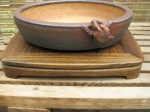
dick benbow- Member
 Re: American Bonsai at the NC Arboretum
Re: American Bonsai at the NC Arboretum
dick benbow wrote: Arthur comes to the Pacific northwest in March. Seattle and Portland area clubs will have an opportunity to see and appreciate his artistry. I'm really into local trees,
so birds of a feather.... will happily get together.
Sweet!!! You'll like him. He has great presentations. His favorite music is rap with artists like DMX, NAS, Jay-Z, pretty much anyone from New York. You should play Nas's "If I ruled the world" as he's being introduced
By the way, for full disclosure just in case you get ideas, I'm completely joking about the rap music

Sam Ogranaja- Member
 Re: American Bonsai at the NC Arboretum
Re: American Bonsai at the NC Arboretum
though he was fortunate enough to have seen the clash...
twice.
sorry arthur, but now we are even-steven in the outing dept

twice.
sorry arthur, but now we are even-steven in the outing dept

Kevin S - Wisco Bonsai- Member
 Heart Full of Hollow
Heart Full of Hollow
Many thanks to those who have posted replies in the last couple of weeks, and particularly to my buddy John G. for making and posting the hornbeam video. As Stephen, Richard, Kevin, Doug and Sam all testified, John G. continues to make an important contribution to the bonsai community with his YouTube channel. It provides straightforward and practical information, gleaned from first-hand experience. As I see it, John's sole purpose is to freely share what he knows with others who have the interest, so his videos are vehicles of communication and not a chance for him to make a name for himself or show off slick production values. Just as John is not in the "business" of making videos, he is not in the "business" of doing bonsai. Which is to say he is not a paid professional, although he has talent enough to be one. Like most of the people who read this forum, he does bonsai purely for the enjoyment of it, but he has attained a level of skill that not so many non-professionals do.
In answer to the comment by Dick B. - I am looking forward to my upcoming visit to the Seattle area and will appreciate meeting you! This is my first foray into west coast bonsai and I am hoping a few people will show up for it. It feels a bit like traveling to a foreign country, but I will be hosted by Dan and Diane Robinson and I know they will make me feel at home.
In my previous post I was discussing the importance of the ability of woody plants, and other things, to recover from calamity. I closed with a photograph of a living tree I came across here in the mountains of North Carolina, that looked like it might have been blasted with an explosive charge a long time ago and somehow survived and recovered. (Actually, to me it looks like some alien in the act of giving birth, but that is a purely subjective perspective.) My friend Steve, in his reply, wondered how it came to look that way, and I cannot offer any likely explanation. I know of another tree, however, that also bears the marks of having lived through a traumatic event, and in this case I can explain it. As it happens, this tree is a Red Maple (Acer rubrum), a species in which Steve expressed interest in an earlier post, and it is a bonsai-in-training.
To begin with, here is what it looks like today:

This specimen stands 28in (71.1cm) in height, and has a diameter of 8in (20.3cm) just above the surface roots.
Sometime back in the early 2000's this red maple was languishing in the Arboretum's container nursery, intended for landscape use but somehow never finding a home. It became pot-bound in its big plastic nursery can, and because it was about 6ft (1.8m) tall it was prone to falling down whenever the wind blew. Eventually it was viewed as a nuisance and scheduled for de-accessioning. The tree had some size in the trunk, and a well formed base with good surface roots, however, and so it caught my eye. I saved it from the compost pile, cut it down to its lowest branch and transferred it from the nursery to the bonsai area, where it was then neglected a few more years but was no longer prone to falling over. Finally, out of sympathy for its still pot-bound condition and concern at how slowly it was producing callous material to cover the gaping wound left by the trunk chop, I put the maple in a grow bed. Here is the first image I have of this tree, made late in 2008 after it had been in the ground a year or 2:
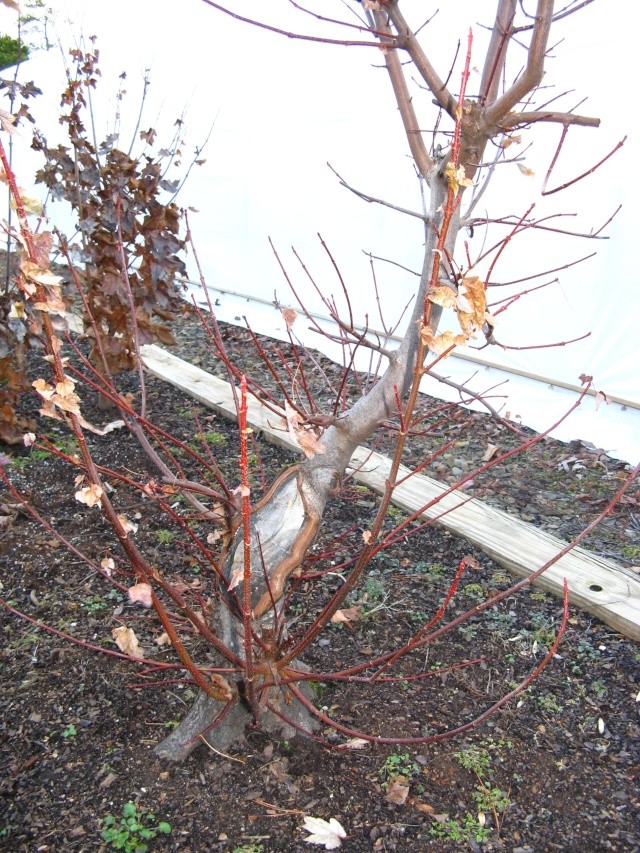
At this point I decided I might not live long enough to see the big wound completely cover. Feeling experimental, or perhaps sadistic, I chopped the tree again. Here is what it looked like in April of '09, the nadir of this maple's existence:

Poor tree! But do not despair - this is a red maple we are talking about, and if it was chopped right down to the ground it would likely grow again from the roots. I let it have 2 seasons of more or less undisturbed growth, which produced this result in February of 2011:
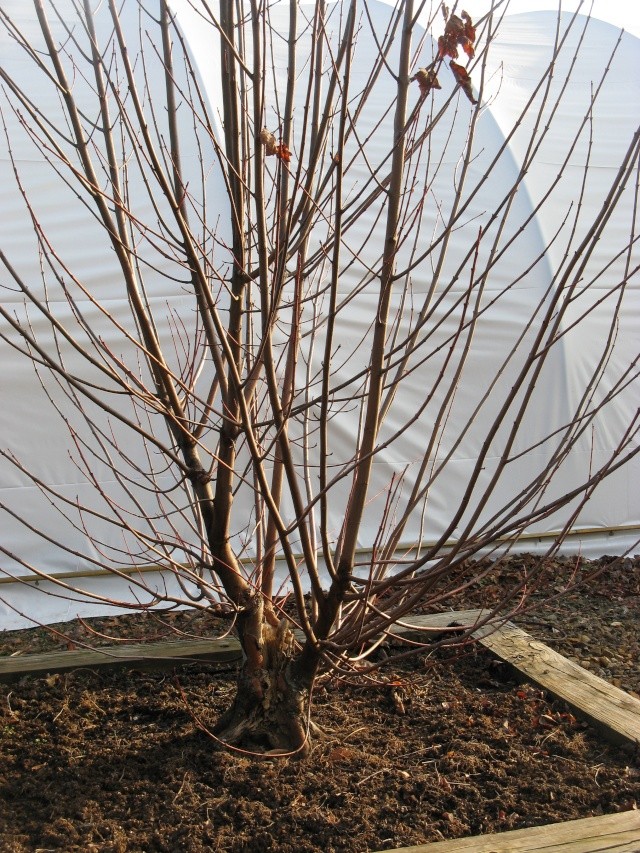
Obviously, the tree survived the brutality of being twice chopped, but not without paying a price. Closing in on the above photograph, we can see that the resulting wound proved too large to cover over and the exposed wood decayed:
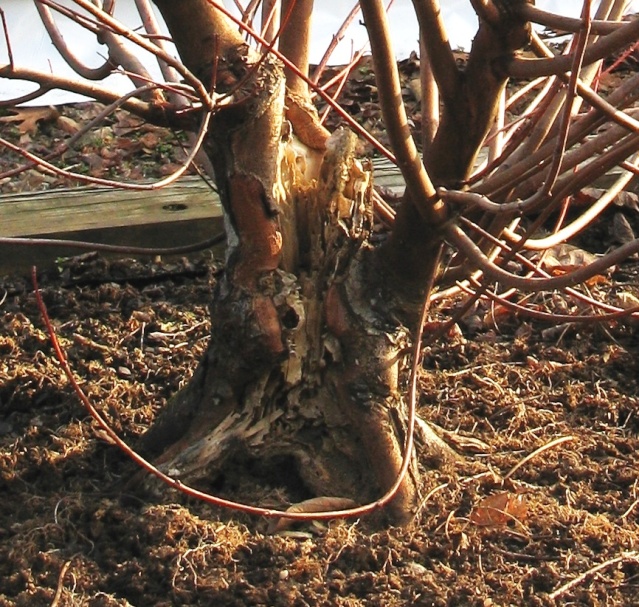
In addition to the decay, the doughty wood was attacked by termites that chewed vertical channels in it right down to the soil and then some. This prompted me to lift the tree out of the earth and plant it in a very large grow box, where I could eradicate the termites and make certain they did not return. I cleaned up the unstable dead wood but left as much of the termite's carving as I could. Here is what the result looked like in April of 2011:
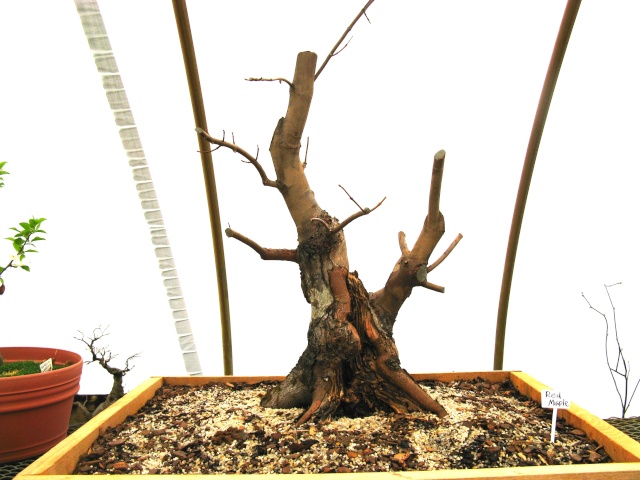
In order to encourage the plant as it made the transition from growing in the earth to once more growing in a container, I did not prune it that growing season. Here is what it looked like nearly a year later, in March of 2012:
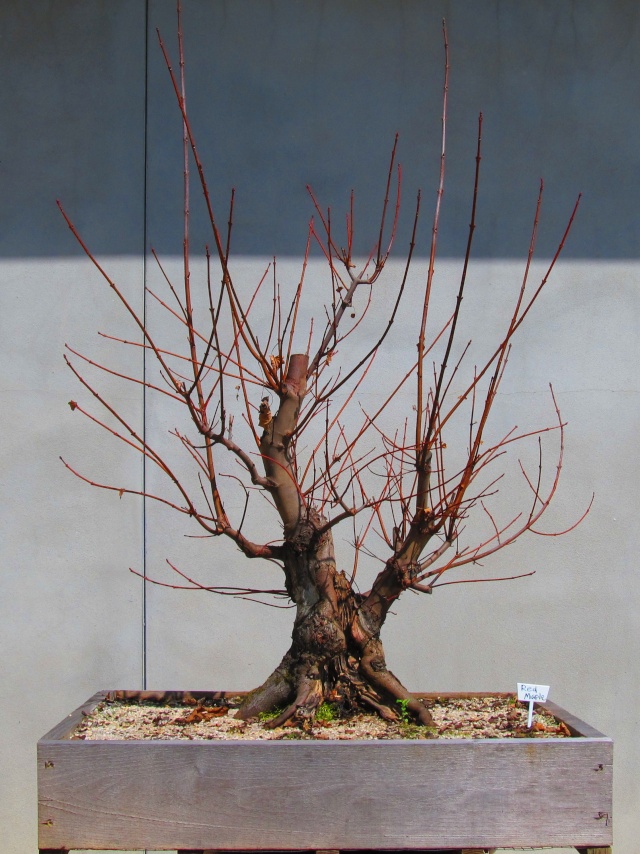
I spent a few hours sorting through all the new growth, cutting much of it away but retaining all branching I thought might serve my purpose. I also devoted a little time to further protecting the core of the tree, as red maple wood does not hold up particularly well to outdoor exposure. I burnished it with a small torch, brushed it clean and then treated it with wood hardener. This picture was made the same day as the previous one:

Among several traits that make red maple a desirable candidate for bonsai use, its propensity for outstanding autumn color should not be overlooked. This image was made in November of 2013, but this specimen produces a similar foliage display every year:
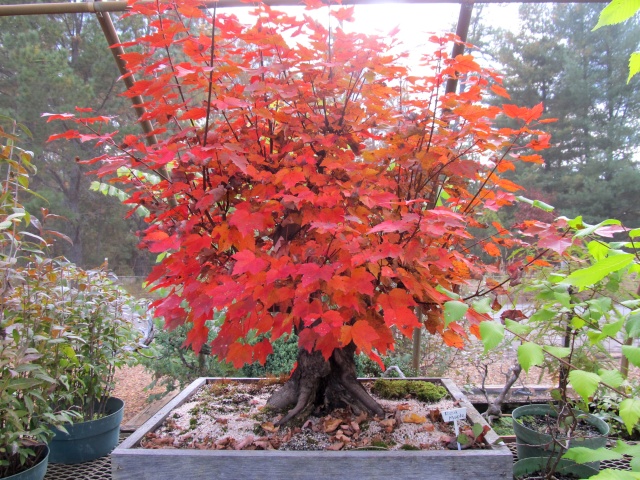
Later that same month, once the leaves dropped, the tree had this appearance:
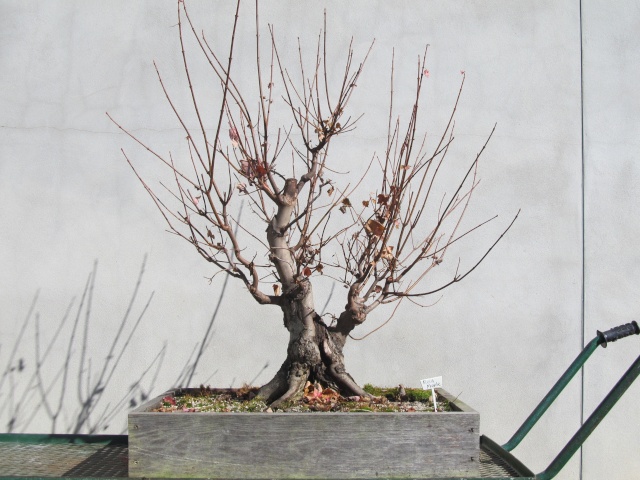
At this time I decided to transplant it into a smaller grow box, in preparation for eventually getting it into an appropriately sized bonsai container. Just as we carefully work the top of a tree in development, incrementally bringing it into bonsai form, so too we should be simultaneously working the root system step by step. When I transplanted this maple from the ground into a grow box in 2011, I decided to minimize the trauma by not bare-rooting it just yet. But now I felt it was ready. Here is the naked tree, showing a fibrous root system in excellent condition:
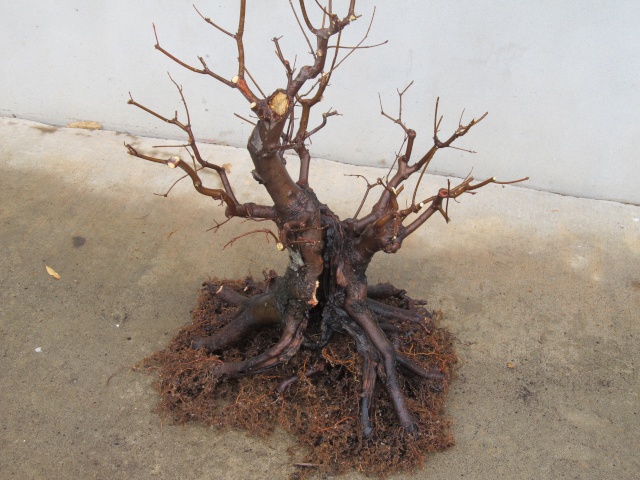
Please note that this bare-root transplanting was done in the month of November. The large number of trees I am caring for dictates that I must do some of my repotting at times that are less than optimal. I have experienced little difficulty with having to do this, and no problem at all with doing it to red maples. Asheville is in zone 7a (historically we were 6b, but that was recently changed to reflect the effects of climate change) so we do get cold. Not Minnesota cold, but teens and single digit and sometimes even below zero Fahrenheit cold. The winter of '13 - '14 was particularly cold, and this maple went through it after being bare-root repotted in mid-November. The only protection from the elements it received was being located in an unheated hoop house that was covered with white polypropylene. It was up on a bench, too, not set down on the ground. I am not by any means recommending that other bonsai growers should do this; as previously indicated, I do it out of necessity. The point is, red maples are tough trees.
Here we see the tree at the conclusion of the November, 2013 repotting session:

I have no images of this specimen to show from 2014. It grew strongly, however, and I pruned it just once, about June, using the patented Walter Pall Hedge-cutting Method. I recently did its annual intensive shaping, but, remarkably, I failed to take "before" pictures. I did do a round of "after" pictures, however. Here they are, with the final shot being the primary view:



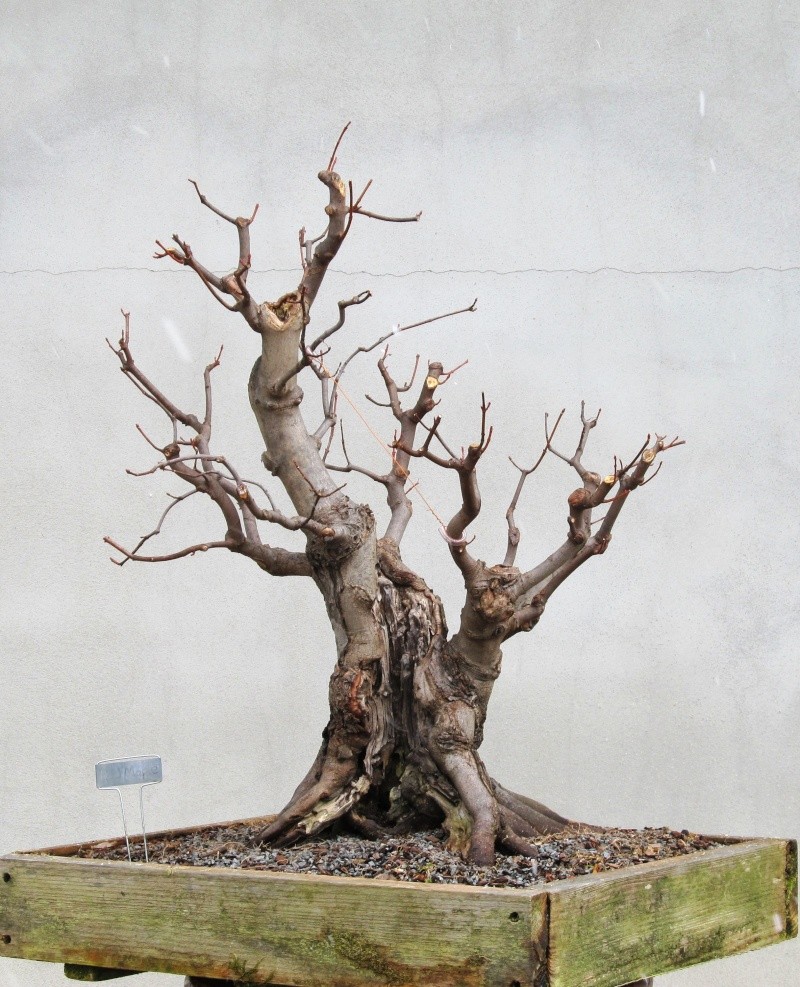
Last September at the 4th US National Bonsai Exhibition I was pleased to find bonsai potter Sara Rayner among the vendors. I purchased this container from her:

When she was wrapping it up, she said, "So, you must have a big maple to put in this?"
I answered, "Oh yes, I think I have just the one!"
In answer to the comment by Dick B. - I am looking forward to my upcoming visit to the Seattle area and will appreciate meeting you! This is my first foray into west coast bonsai and I am hoping a few people will show up for it. It feels a bit like traveling to a foreign country, but I will be hosted by Dan and Diane Robinson and I know they will make me feel at home.
In my previous post I was discussing the importance of the ability of woody plants, and other things, to recover from calamity. I closed with a photograph of a living tree I came across here in the mountains of North Carolina, that looked like it might have been blasted with an explosive charge a long time ago and somehow survived and recovered. (Actually, to me it looks like some alien in the act of giving birth, but that is a purely subjective perspective.) My friend Steve, in his reply, wondered how it came to look that way, and I cannot offer any likely explanation. I know of another tree, however, that also bears the marks of having lived through a traumatic event, and in this case I can explain it. As it happens, this tree is a Red Maple (Acer rubrum), a species in which Steve expressed interest in an earlier post, and it is a bonsai-in-training.
To begin with, here is what it looks like today:

This specimen stands 28in (71.1cm) in height, and has a diameter of 8in (20.3cm) just above the surface roots.
Sometime back in the early 2000's this red maple was languishing in the Arboretum's container nursery, intended for landscape use but somehow never finding a home. It became pot-bound in its big plastic nursery can, and because it was about 6ft (1.8m) tall it was prone to falling down whenever the wind blew. Eventually it was viewed as a nuisance and scheduled for de-accessioning. The tree had some size in the trunk, and a well formed base with good surface roots, however, and so it caught my eye. I saved it from the compost pile, cut it down to its lowest branch and transferred it from the nursery to the bonsai area, where it was then neglected a few more years but was no longer prone to falling over. Finally, out of sympathy for its still pot-bound condition and concern at how slowly it was producing callous material to cover the gaping wound left by the trunk chop, I put the maple in a grow bed. Here is the first image I have of this tree, made late in 2008 after it had been in the ground a year or 2:

At this point I decided I might not live long enough to see the big wound completely cover. Feeling experimental, or perhaps sadistic, I chopped the tree again. Here is what it looked like in April of '09, the nadir of this maple's existence:

Poor tree! But do not despair - this is a red maple we are talking about, and if it was chopped right down to the ground it would likely grow again from the roots. I let it have 2 seasons of more or less undisturbed growth, which produced this result in February of 2011:

Obviously, the tree survived the brutality of being twice chopped, but not without paying a price. Closing in on the above photograph, we can see that the resulting wound proved too large to cover over and the exposed wood decayed:

In addition to the decay, the doughty wood was attacked by termites that chewed vertical channels in it right down to the soil and then some. This prompted me to lift the tree out of the earth and plant it in a very large grow box, where I could eradicate the termites and make certain they did not return. I cleaned up the unstable dead wood but left as much of the termite's carving as I could. Here is what the result looked like in April of 2011:

In order to encourage the plant as it made the transition from growing in the earth to once more growing in a container, I did not prune it that growing season. Here is what it looked like nearly a year later, in March of 2012:

I spent a few hours sorting through all the new growth, cutting much of it away but retaining all branching I thought might serve my purpose. I also devoted a little time to further protecting the core of the tree, as red maple wood does not hold up particularly well to outdoor exposure. I burnished it with a small torch, brushed it clean and then treated it with wood hardener. This picture was made the same day as the previous one:

Among several traits that make red maple a desirable candidate for bonsai use, its propensity for outstanding autumn color should not be overlooked. This image was made in November of 2013, but this specimen produces a similar foliage display every year:

Later that same month, once the leaves dropped, the tree had this appearance:

At this time I decided to transplant it into a smaller grow box, in preparation for eventually getting it into an appropriately sized bonsai container. Just as we carefully work the top of a tree in development, incrementally bringing it into bonsai form, so too we should be simultaneously working the root system step by step. When I transplanted this maple from the ground into a grow box in 2011, I decided to minimize the trauma by not bare-rooting it just yet. But now I felt it was ready. Here is the naked tree, showing a fibrous root system in excellent condition:

Please note that this bare-root transplanting was done in the month of November. The large number of trees I am caring for dictates that I must do some of my repotting at times that are less than optimal. I have experienced little difficulty with having to do this, and no problem at all with doing it to red maples. Asheville is in zone 7a (historically we were 6b, but that was recently changed to reflect the effects of climate change) so we do get cold. Not Minnesota cold, but teens and single digit and sometimes even below zero Fahrenheit cold. The winter of '13 - '14 was particularly cold, and this maple went through it after being bare-root repotted in mid-November. The only protection from the elements it received was being located in an unheated hoop house that was covered with white polypropylene. It was up on a bench, too, not set down on the ground. I am not by any means recommending that other bonsai growers should do this; as previously indicated, I do it out of necessity. The point is, red maples are tough trees.
Here we see the tree at the conclusion of the November, 2013 repotting session:

I have no images of this specimen to show from 2014. It grew strongly, however, and I pruned it just once, about June, using the patented Walter Pall Hedge-cutting Method. I recently did its annual intensive shaping, but, remarkably, I failed to take "before" pictures. I did do a round of "after" pictures, however. Here they are, with the final shot being the primary view:




Last September at the 4th US National Bonsai Exhibition I was pleased to find bonsai potter Sara Rayner among the vendors. I purchased this container from her:

When she was wrapping it up, she said, "So, you must have a big maple to put in this?"
I answered, "Oh yes, I think I have just the one!"

Arthur Joura- Member
 Re: American Bonsai at the NC Arboretum
Re: American Bonsai at the NC Arboretum
thank-you for sharing your maple and pot. Stunning......
If it wasn't for folks like john, who genuinely care about helping others, american bonsai would be furthur behind and having a longer way to go to catchup.
We're fortunate here in the northwest to have the likes of Dan Robinson and David De Groot with the same attitude.
If it wasn't for folks like john, who genuinely care about helping others, american bonsai would be furthur behind and having a longer way to go to catchup.
We're fortunate here in the northwest to have the likes of Dan Robinson and David De Groot with the same attitude.

dick benbow- Member
 Re: American Bonsai at the NC Arboretum
Re: American Bonsai at the NC Arboretum
Wow Arthur.
I mean, really. From such formerly 'disreputable', locally grown/available material, as Acer rubrum..... we have this?
It's all about the root base, man. Or, shall I simply say: "OMG".
Translation?
Oh. My. God.
Really.
That Nebari *ahem* 'Root Base' is just about, World Class.
Thanks as always, Arthur. Your posts are as always, informative. Educational.
Even,
Entertaining.
I mean, really. From such formerly 'disreputable', locally grown/available material, as Acer rubrum..... we have this?
It's all about the root base, man. Or, shall I simply say: "OMG".
Translation?
Oh. My. God.
Really.
That Nebari *ahem* 'Root Base' is just about, World Class.
Thanks as always, Arthur. Your posts are as always, informative. Educational.
Even,
Entertaining.

Auballagh- Member
 Re: American Bonsai at the NC Arboretum
Re: American Bonsai at the NC Arboretum
A wonderful posting, Arthur. Way back in 1978 Jerry Stowell extolled the value of A. rubrum as an "American" bonsai. I'd tried to follow him on many occasions, finally giving up because I favor trees that are small, and this species cries for existence as a larger bonsai. Your work here shows how right Jerry was.
Thanks.
Thanks.

JimLewis- Member
 Re: American Bonsai at the NC Arboretum
Re: American Bonsai at the NC Arboretum
HI Arthur,
Great post on such an under-used, but very good bonsai species. One of the things I think this post shows is that how little time it takes to get an Acer rubrum in to a really nice base structure for bonsai. In just a few season this species can really put on a lot of wood when given a good growing situation, This is also similarly true with Trident maples, verses having to wait decades for pines species for instance. I personally like it when scaring occurs on deciduous material. Nothing say "old" to me like a tree that has huge wounds, or a massive base with surface roots. I have seen it so many times in nature. Nature may not always be pretty, but it is always beautiful.
Steve
P.S. Love the Alien reference in your post....
Great post on such an under-used, but very good bonsai species. One of the things I think this post shows is that how little time it takes to get an Acer rubrum in to a really nice base structure for bonsai. In just a few season this species can really put on a lot of wood when given a good growing situation, This is also similarly true with Trident maples, verses having to wait decades for pines species for instance. I personally like it when scaring occurs on deciduous material. Nothing say "old" to me like a tree that has huge wounds, or a massive base with surface roots. I have seen it so many times in nature. Nature may not always be pretty, but it is always beautiful.
Steve
P.S. Love the Alien reference in your post....

Stephen Krall- Member
 Re: American Bonsai at the NC Arboretum
Re: American Bonsai at the NC Arboretum
Awesome Acer! This is well on it's way to being a very nice tree/bonsai. Great work Arthur!
Thank you for keeping such great records and progression photo's; They add tremendously to your already valuable information and insight.
Thank you for keeping such great records and progression photo's; They add tremendously to your already valuable information and insight.

Dan W.- Member
 Re: American Bonsai at the NC Arboretum
Re: American Bonsai at the NC Arboretum
I'm looking forward to seeing the tree potted. Do you plan to do it this spring?

Dan W.- Member
Page 15 of 40 •  1 ... 9 ... 14, 15, 16 ... 27 ... 40
1 ... 9 ... 14, 15, 16 ... 27 ... 40 
 Similar topics
Similar topics» American Bonsai at the NC Arboretum
» WISTERIA BONSAI AT INTERNATIONAL BONSAI ARBORETUM
» Ashville arboretum bonsai
» Carolina Bonsai Expo @ NC Arboretum
» Autumn at the NC Arboretum bonsai garden
» WISTERIA BONSAI AT INTERNATIONAL BONSAI ARBORETUM
» Ashville arboretum bonsai
» Carolina Bonsai Expo @ NC Arboretum
» Autumn at the NC Arboretum bonsai garden
Page 15 of 40
Permissions in this forum:
You cannot reply to topics in this forum|
|
|







